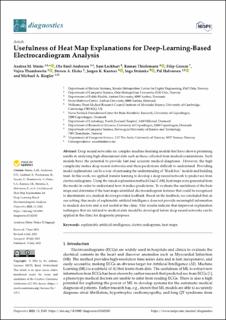Usefulness of Heat Map Explanations for Deep-Learning-Based Electrocardiogram Analysis
Storås, Andrea; Andersen, Ole Emil; Lockhart, Sam; Thielemann, Roman; Gnesin, Filip; Thambawita, Vajira L B; Hicks, Steven; Kanters, Jørgen K.; Strumke, Inga; Halvorsen, Pål; Riegler, Michael
Peer reviewed, Journal article
Published version
Permanent lenke
https://hdl.handle.net/11250/3087279Utgivelsesdato
2023Metadata
Vis full innførselSamlinger
Sammendrag
Deep neural networks are complex machine learning models that have shown promising
results in analyzing high-dimensional data such as those collected from medical examinations. Such
models have the potential to provide fast and accurate medical diagnoses. However, the high
complexity makes deep neural networks and their predictions difficult to understand. Providing
model explanations can be a way of increasing the understanding of “black box” models and building
trust. In this work, we applied transfer learning to develop a deep neural network to predict sex from
electrocardiograms. Using the visual explanation method Grad-CAM, heat maps were generated from
the model in order to understand how it makes predictions. To evaluate the usefulness of the heat
maps and determine if the heat maps identified electrocardiogram features that could be recognized
to discriminate sex, medical doctors provided feedback. Based on the feedback, we concluded that, in
our setting, this mode of explainable artificial intelligence does not provide meaningful information
to medical doctors and is not useful in the clinic. Our results indicate that improved explanation
techniques that are tailored to medical data should be developed before deep neural networks can be
applied in the clinic for diagnostic purposes.

